The Reconciliation of Economic and Environmental Challenges Essay
VerifiedAdded on 2022/08/22
|8
|1740
|18
Essay
AI Summary
This essay delves into the critical intersection of economic development and environmental protection in the 21st century, with a specific focus on reconciling economic growth with the pressing challenges of climate change and resource management. The paper begins by highlighting the increasing environmental challenges and the need for new management and research approaches. It then discusses the impact of human activities on environmental issues, including biodiversity loss and climate change. The essay explores how economic systems often fail to internalize environmental externalities, leading to market failures and unsustainable practices. It examines the economic consequences of climate change, including the social cost of carbon and the uncertainties in predicting its impact on global welfare. The author argues for a transition towards a low-carbon growth model, emphasizing the need for energy efficiency, halting deforestation, and implementing effective public policies. The essay concludes by emphasizing the need for economic systems to adapt to environmental constraints and integrate environmental, economic, and social dimensions for a more sustainable future, urging governments to consider the limitations of GDP as a measure of economic growth. The essay references several academic sources to support its arguments and conclusions.
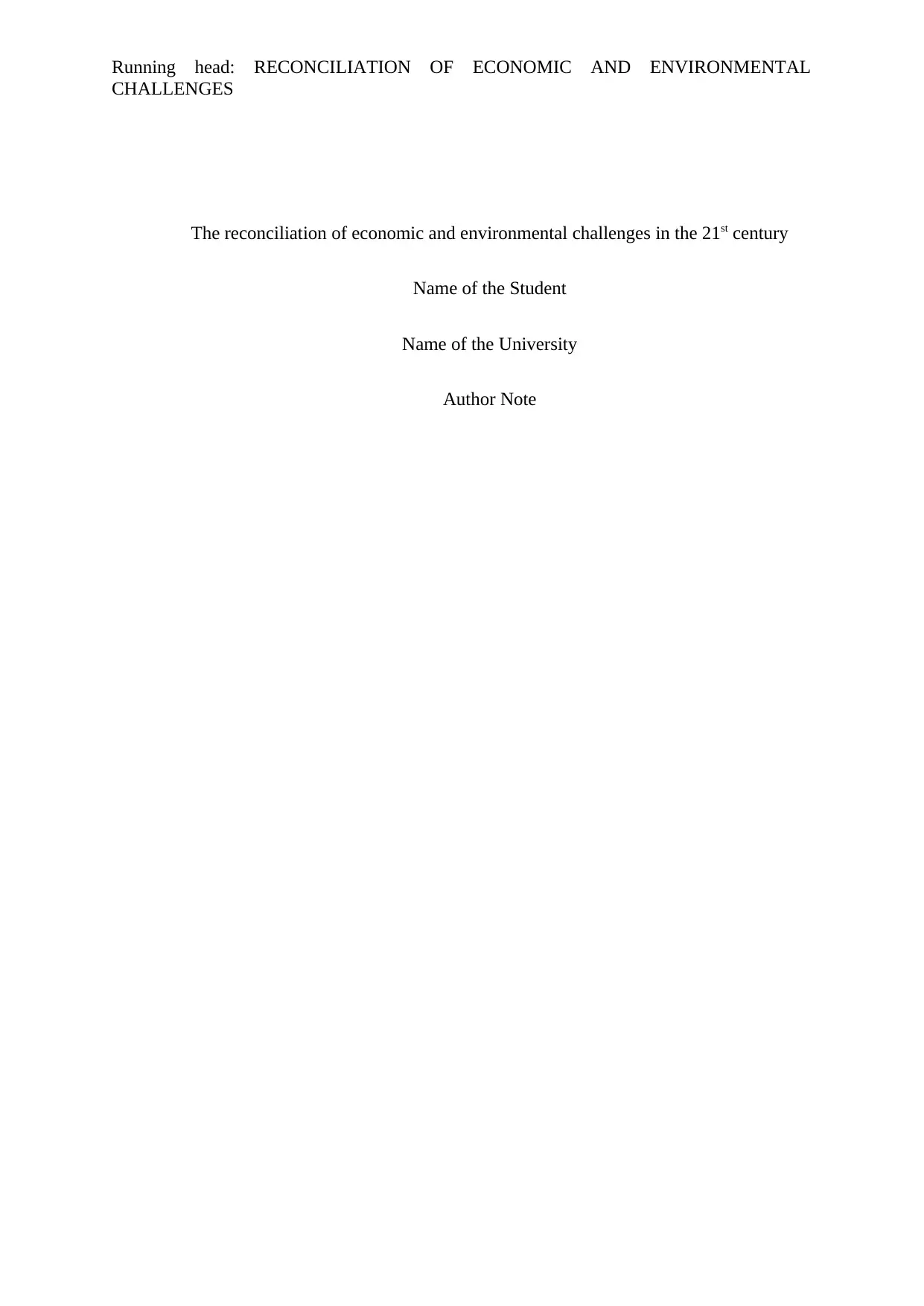
Running head: RECONCILIATION OF ECONOMIC AND ENVIRONMENTAL
CHALLENGES
The reconciliation of economic and environmental challenges in the 21st century
Name of the Student
Name of the University
Author Note
CHALLENGES
The reconciliation of economic and environmental challenges in the 21st century
Name of the Student
Name of the University
Author Note
Paraphrase This Document
Need a fresh take? Get an instant paraphrase of this document with our AI Paraphraser
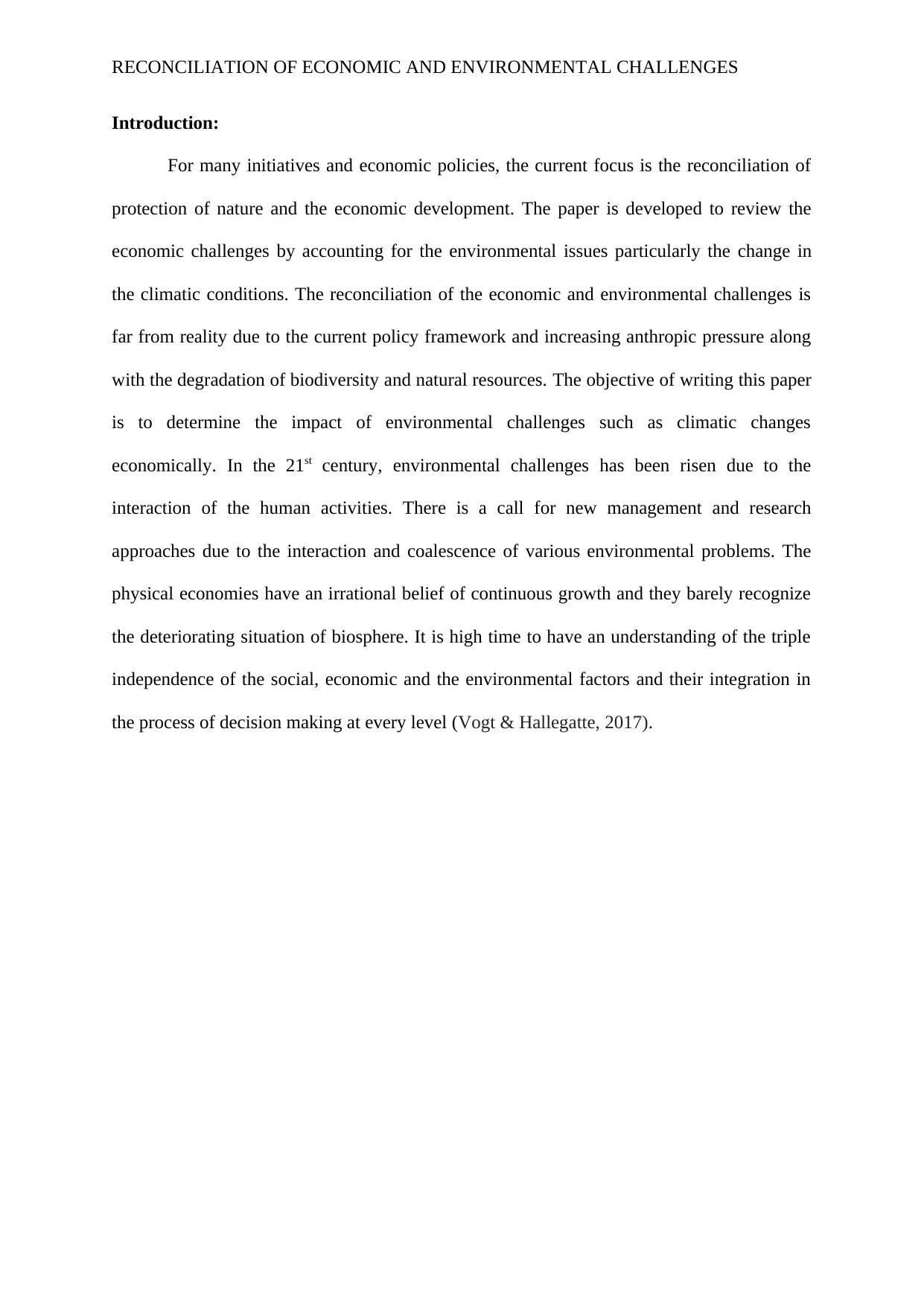
RECONCILIATION OF ECONOMIC AND ENVIRONMENTAL CHALLENGES
Introduction:
For many initiatives and economic policies, the current focus is the reconciliation of
protection of nature and the economic development. The paper is developed to review the
economic challenges by accounting for the environmental issues particularly the change in
the climatic conditions. The reconciliation of the economic and environmental challenges is
far from reality due to the current policy framework and increasing anthropic pressure along
with the degradation of biodiversity and natural resources. The objective of writing this paper
is to determine the impact of environmental challenges such as climatic changes
economically. In the 21st century, environmental challenges has been risen due to the
interaction of the human activities. There is a call for new management and research
approaches due to the interaction and coalescence of various environmental problems. The
physical economies have an irrational belief of continuous growth and they barely recognize
the deteriorating situation of biosphere. It is high time to have an understanding of the triple
independence of the social, economic and the environmental factors and their integration in
the process of decision making at every level (Vogt & Hallegatte, 2017).
Introduction:
For many initiatives and economic policies, the current focus is the reconciliation of
protection of nature and the economic development. The paper is developed to review the
economic challenges by accounting for the environmental issues particularly the change in
the climatic conditions. The reconciliation of the economic and environmental challenges is
far from reality due to the current policy framework and increasing anthropic pressure along
with the degradation of biodiversity and natural resources. The objective of writing this paper
is to determine the impact of environmental challenges such as climatic changes
economically. In the 21st century, environmental challenges has been risen due to the
interaction of the human activities. There is a call for new management and research
approaches due to the interaction and coalescence of various environmental problems. The
physical economies have an irrational belief of continuous growth and they barely recognize
the deteriorating situation of biosphere. It is high time to have an understanding of the triple
independence of the social, economic and the environmental factors and their integration in
the process of decision making at every level (Vogt & Hallegatte, 2017).
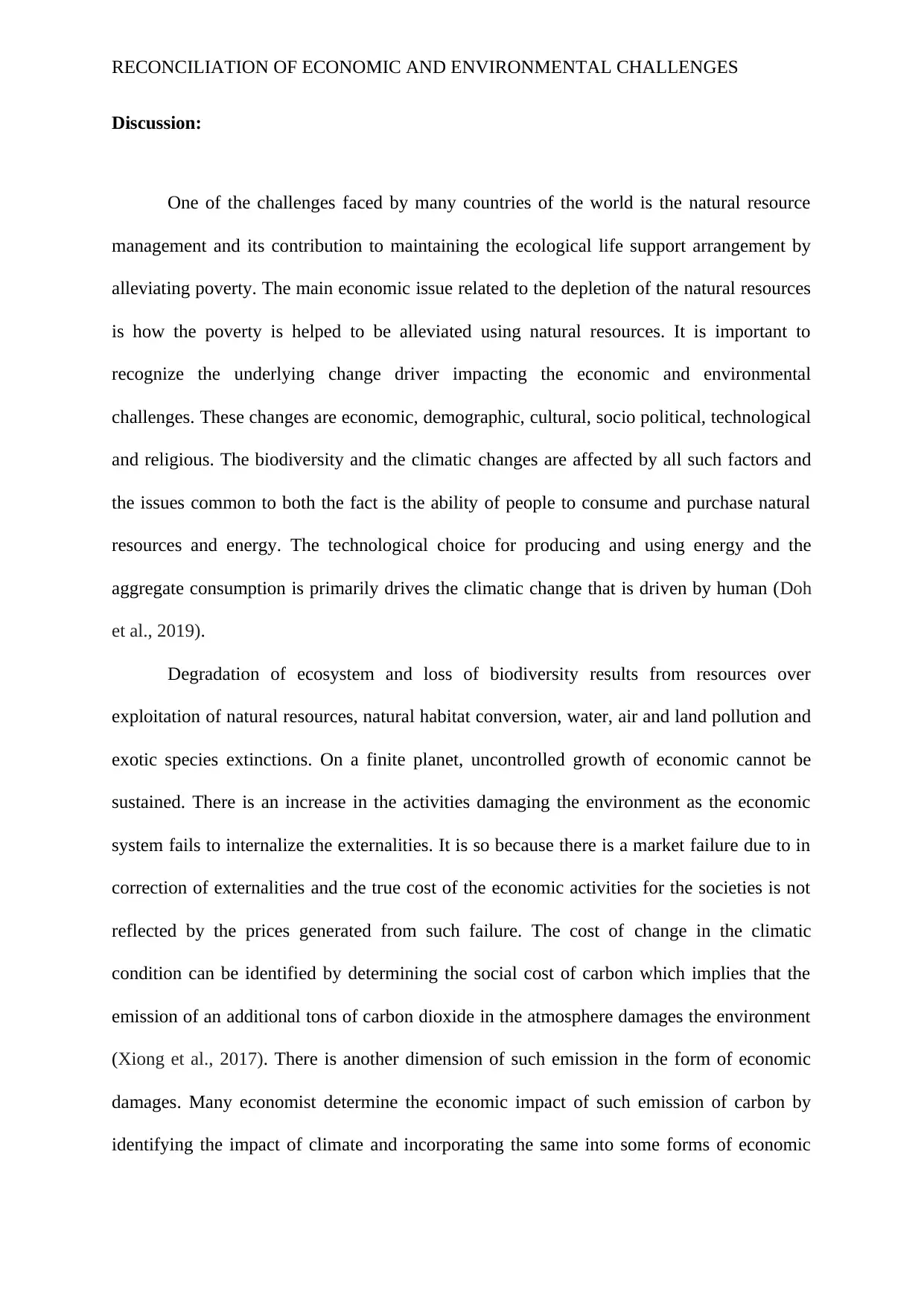
RECONCILIATION OF ECONOMIC AND ENVIRONMENTAL CHALLENGES
Discussion:
One of the challenges faced by many countries of the world is the natural resource
management and its contribution to maintaining the ecological life support arrangement by
alleviating poverty. The main economic issue related to the depletion of the natural resources
is how the poverty is helped to be alleviated using natural resources. It is important to
recognize the underlying change driver impacting the economic and environmental
challenges. These changes are economic, demographic, cultural, socio political, technological
and religious. The biodiversity and the climatic changes are affected by all such factors and
the issues common to both the fact is the ability of people to consume and purchase natural
resources and energy. The technological choice for producing and using energy and the
aggregate consumption is primarily drives the climatic change that is driven by human (Doh
et al., 2019).
Degradation of ecosystem and loss of biodiversity results from resources over
exploitation of natural resources, natural habitat conversion, water, air and land pollution and
exotic species extinctions. On a finite planet, uncontrolled growth of economic cannot be
sustained. There is an increase in the activities damaging the environment as the economic
system fails to internalize the externalities. It is so because there is a market failure due to in
correction of externalities and the true cost of the economic activities for the societies is not
reflected by the prices generated from such failure. The cost of change in the climatic
condition can be identified by determining the social cost of carbon which implies that the
emission of an additional tons of carbon dioxide in the atmosphere damages the environment
(Xiong et al., 2017). There is another dimension of such emission in the form of economic
damages. Many economist determine the economic impact of such emission of carbon by
identifying the impact of climate and incorporating the same into some forms of economic
Discussion:
One of the challenges faced by many countries of the world is the natural resource
management and its contribution to maintaining the ecological life support arrangement by
alleviating poverty. The main economic issue related to the depletion of the natural resources
is how the poverty is helped to be alleviated using natural resources. It is important to
recognize the underlying change driver impacting the economic and environmental
challenges. These changes are economic, demographic, cultural, socio political, technological
and religious. The biodiversity and the climatic changes are affected by all such factors and
the issues common to both the fact is the ability of people to consume and purchase natural
resources and energy. The technological choice for producing and using energy and the
aggregate consumption is primarily drives the climatic change that is driven by human (Doh
et al., 2019).
Degradation of ecosystem and loss of biodiversity results from resources over
exploitation of natural resources, natural habitat conversion, water, air and land pollution and
exotic species extinctions. On a finite planet, uncontrolled growth of economic cannot be
sustained. There is an increase in the activities damaging the environment as the economic
system fails to internalize the externalities. It is so because there is a market failure due to in
correction of externalities and the true cost of the economic activities for the societies is not
reflected by the prices generated from such failure. The cost of change in the climatic
condition can be identified by determining the social cost of carbon which implies that the
emission of an additional tons of carbon dioxide in the atmosphere damages the environment
(Xiong et al., 2017). There is another dimension of such emission in the form of economic
damages. Many economist determine the economic impact of such emission of carbon by
identifying the impact of climate and incorporating the same into some forms of economic
⊘ This is a preview!⊘
Do you want full access?
Subscribe today to unlock all pages.

Trusted by 1+ million students worldwide
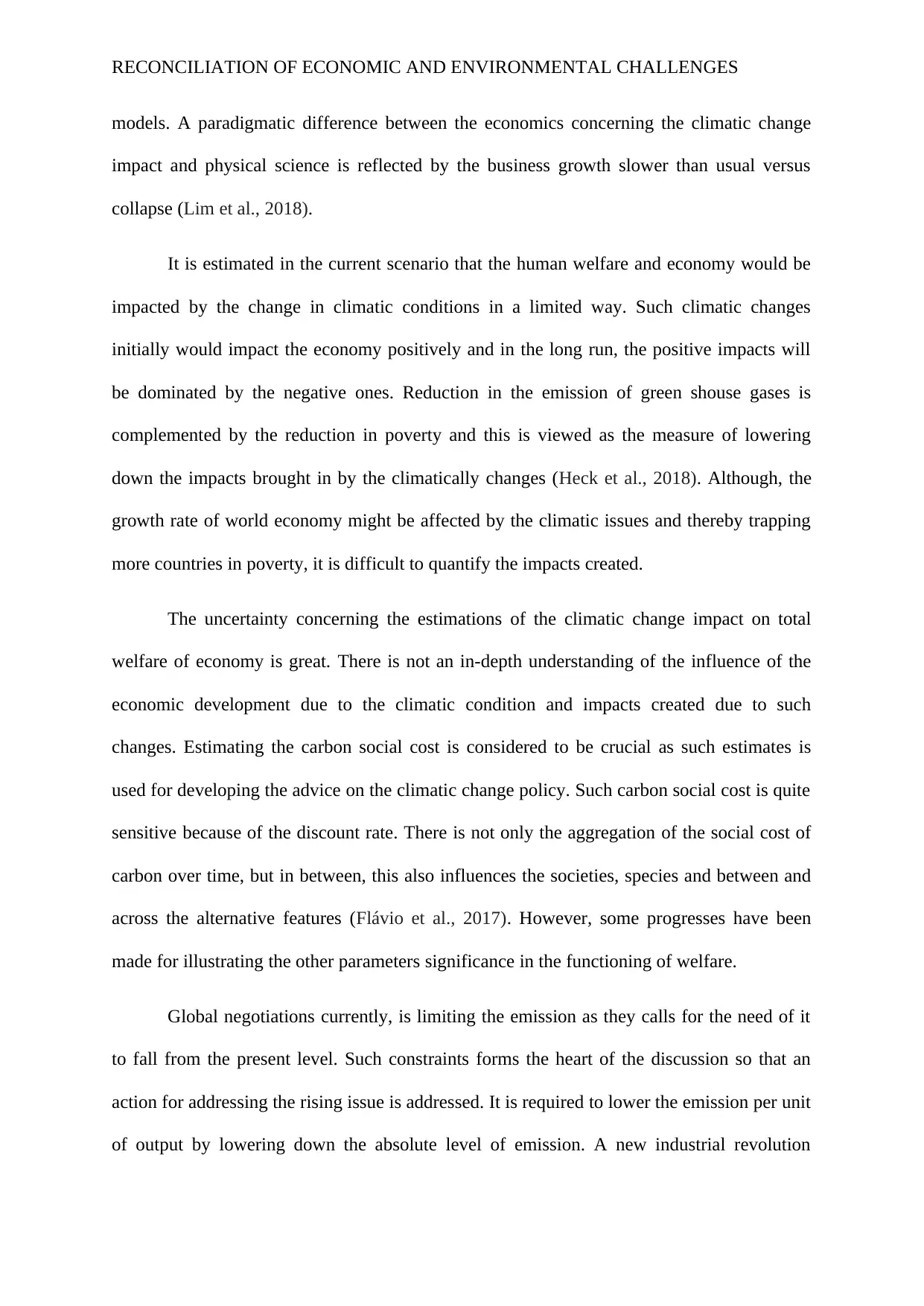
RECONCILIATION OF ECONOMIC AND ENVIRONMENTAL CHALLENGES
models. A paradigmatic difference between the economics concerning the climatic change
impact and physical science is reflected by the business growth slower than usual versus
collapse (Lim et al., 2018).
It is estimated in the current scenario that the human welfare and economy would be
impacted by the change in climatic conditions in a limited way. Such climatic changes
initially would impact the economy positively and in the long run, the positive impacts will
be dominated by the negative ones. Reduction in the emission of green shouse gases is
complemented by the reduction in poverty and this is viewed as the measure of lowering
down the impacts brought in by the climatically changes (Heck et al., 2018). Although, the
growth rate of world economy might be affected by the climatic issues and thereby trapping
more countries in poverty, it is difficult to quantify the impacts created.
The uncertainty concerning the estimations of the climatic change impact on total
welfare of economy is great. There is not an in-depth understanding of the influence of the
economic development due to the climatic condition and impacts created due to such
changes. Estimating the carbon social cost is considered to be crucial as such estimates is
used for developing the advice on the climatic change policy. Such carbon social cost is quite
sensitive because of the discount rate. There is not only the aggregation of the social cost of
carbon over time, but in between, this also influences the societies, species and between and
across the alternative features (Flávio et al., 2017). However, some progresses have been
made for illustrating the other parameters significance in the functioning of welfare.
Global negotiations currently, is limiting the emission as they calls for the need of it
to fall from the present level. Such constraints forms the heart of the discussion so that an
action for addressing the rising issue is addressed. It is required to lower the emission per unit
of output by lowering down the absolute level of emission. A new industrial revolution
models. A paradigmatic difference between the economics concerning the climatic change
impact and physical science is reflected by the business growth slower than usual versus
collapse (Lim et al., 2018).
It is estimated in the current scenario that the human welfare and economy would be
impacted by the change in climatic conditions in a limited way. Such climatic changes
initially would impact the economy positively and in the long run, the positive impacts will
be dominated by the negative ones. Reduction in the emission of green shouse gases is
complemented by the reduction in poverty and this is viewed as the measure of lowering
down the impacts brought in by the climatically changes (Heck et al., 2018). Although, the
growth rate of world economy might be affected by the climatic issues and thereby trapping
more countries in poverty, it is difficult to quantify the impacts created.
The uncertainty concerning the estimations of the climatic change impact on total
welfare of economy is great. There is not an in-depth understanding of the influence of the
economic development due to the climatic condition and impacts created due to such
changes. Estimating the carbon social cost is considered to be crucial as such estimates is
used for developing the advice on the climatic change policy. Such carbon social cost is quite
sensitive because of the discount rate. There is not only the aggregation of the social cost of
carbon over time, but in between, this also influences the societies, species and between and
across the alternative features (Flávio et al., 2017). However, some progresses have been
made for illustrating the other parameters significance in the functioning of welfare.
Global negotiations currently, is limiting the emission as they calls for the need of it
to fall from the present level. Such constraints forms the heart of the discussion so that an
action for addressing the rising issue is addressed. It is required to lower the emission per unit
of output by lowering down the absolute level of emission. A new industrial revolution
Paraphrase This Document
Need a fresh take? Get an instant paraphrase of this document with our AI Paraphraser
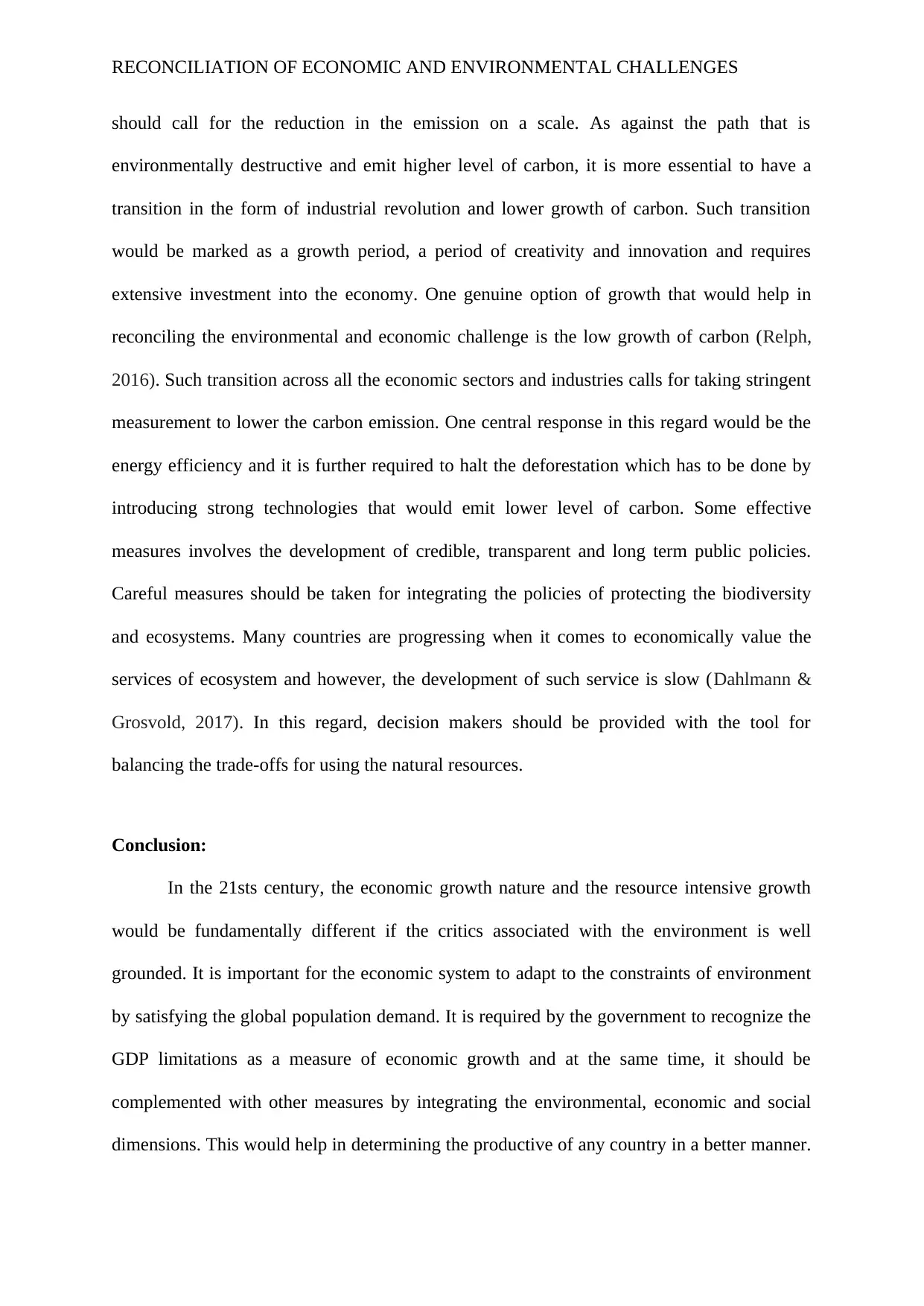
RECONCILIATION OF ECONOMIC AND ENVIRONMENTAL CHALLENGES
should call for the reduction in the emission on a scale. As against the path that is
environmentally destructive and emit higher level of carbon, it is more essential to have a
transition in the form of industrial revolution and lower growth of carbon. Such transition
would be marked as a growth period, a period of creativity and innovation and requires
extensive investment into the economy. One genuine option of growth that would help in
reconciling the environmental and economic challenge is the low growth of carbon (Relph,
2016). Such transition across all the economic sectors and industries calls for taking stringent
measurement to lower the carbon emission. One central response in this regard would be the
energy efficiency and it is further required to halt the deforestation which has to be done by
introducing strong technologies that would emit lower level of carbon. Some effective
measures involves the development of credible, transparent and long term public policies.
Careful measures should be taken for integrating the policies of protecting the biodiversity
and ecosystems. Many countries are progressing when it comes to economically value the
services of ecosystem and however, the development of such service is slow (Dahlmann &
Grosvold, 2017). In this regard, decision makers should be provided with the tool for
balancing the trade-offs for using the natural resources.
Conclusion:
In the 21sts century, the economic growth nature and the resource intensive growth
would be fundamentally different if the critics associated with the environment is well
grounded. It is important for the economic system to adapt to the constraints of environment
by satisfying the global population demand. It is required by the government to recognize the
GDP limitations as a measure of economic growth and at the same time, it should be
complemented with other measures by integrating the environmental, economic and social
dimensions. This would help in determining the productive of any country in a better manner.
should call for the reduction in the emission on a scale. As against the path that is
environmentally destructive and emit higher level of carbon, it is more essential to have a
transition in the form of industrial revolution and lower growth of carbon. Such transition
would be marked as a growth period, a period of creativity and innovation and requires
extensive investment into the economy. One genuine option of growth that would help in
reconciling the environmental and economic challenge is the low growth of carbon (Relph,
2016). Such transition across all the economic sectors and industries calls for taking stringent
measurement to lower the carbon emission. One central response in this regard would be the
energy efficiency and it is further required to halt the deforestation which has to be done by
introducing strong technologies that would emit lower level of carbon. Some effective
measures involves the development of credible, transparent and long term public policies.
Careful measures should be taken for integrating the policies of protecting the biodiversity
and ecosystems. Many countries are progressing when it comes to economically value the
services of ecosystem and however, the development of such service is slow (Dahlmann &
Grosvold, 2017). In this regard, decision makers should be provided with the tool for
balancing the trade-offs for using the natural resources.
Conclusion:
In the 21sts century, the economic growth nature and the resource intensive growth
would be fundamentally different if the critics associated with the environment is well
grounded. It is important for the economic system to adapt to the constraints of environment
by satisfying the global population demand. It is required by the government to recognize the
GDP limitations as a measure of economic growth and at the same time, it should be
complemented with other measures by integrating the environmental, economic and social
dimensions. This would help in determining the productive of any country in a better manner.

RECONCILIATION OF ECONOMIC AND ENVIRONMENTAL CHALLENGES
It is argued by some authors that there is no foundation of the evaluating the climatic changes
impact in the economic theory.
It is argued by some authors that there is no foundation of the evaluating the climatic changes
impact in the economic theory.
⊘ This is a preview!⊘
Do you want full access?
Subscribe today to unlock all pages.

Trusted by 1+ million students worldwide
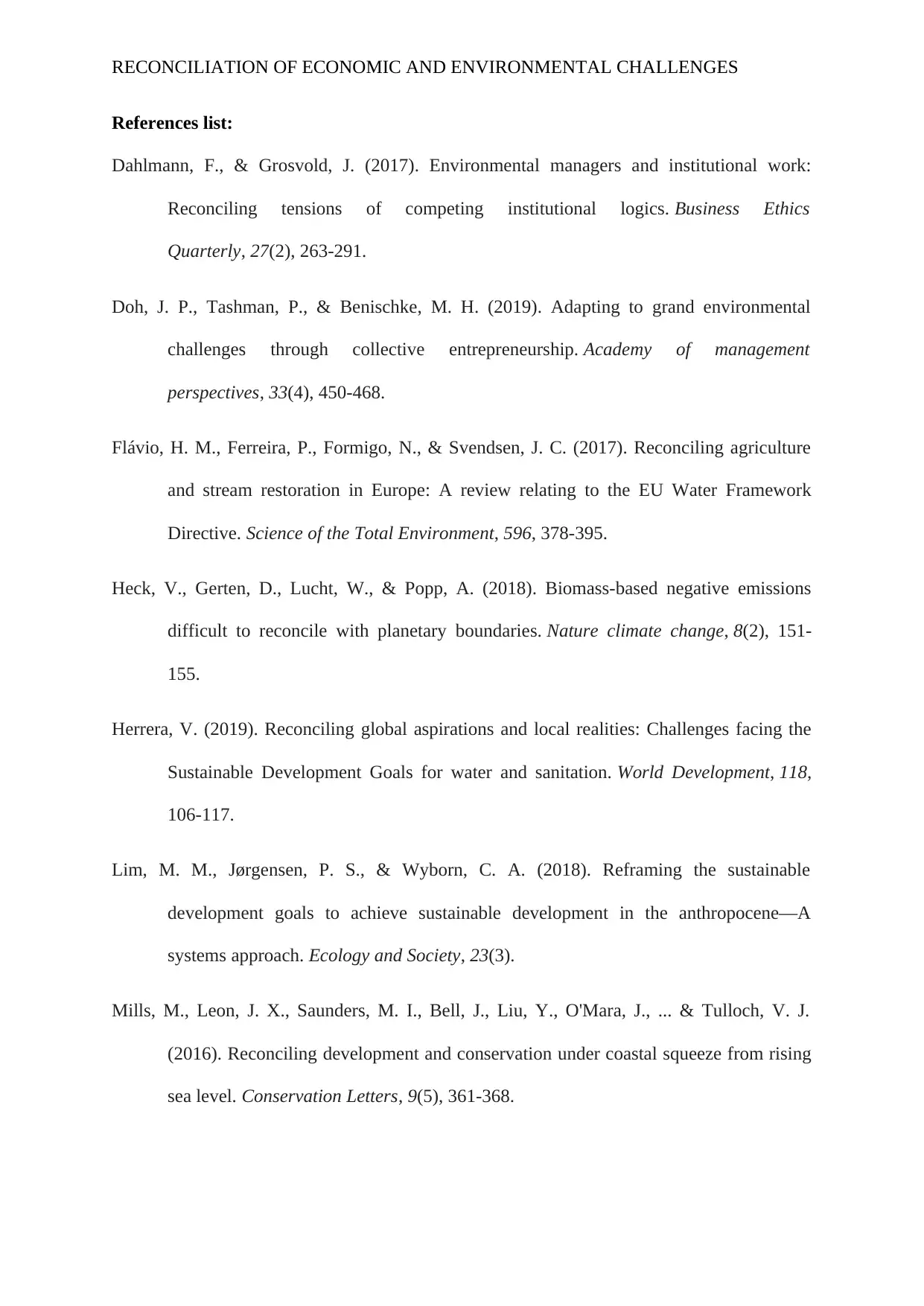
RECONCILIATION OF ECONOMIC AND ENVIRONMENTAL CHALLENGES
References list:
Dahlmann, F., & Grosvold, J. (2017). Environmental managers and institutional work:
Reconciling tensions of competing institutional logics. Business Ethics
Quarterly, 27(2), 263-291.
Doh, J. P., Tashman, P., & Benischke, M. H. (2019). Adapting to grand environmental
challenges through collective entrepreneurship. Academy of management
perspectives, 33(4), 450-468.
Flávio, H. M., Ferreira, P., Formigo, N., & Svendsen, J. C. (2017). Reconciling agriculture
and stream restoration in Europe: A review relating to the EU Water Framework
Directive. Science of the Total Environment, 596, 378-395.
Heck, V., Gerten, D., Lucht, W., & Popp, A. (2018). Biomass-based negative emissions
difficult to reconcile with planetary boundaries. Nature climate change, 8(2), 151-
155.
Herrera, V. (2019). Reconciling global aspirations and local realities: Challenges facing the
Sustainable Development Goals for water and sanitation. World Development, 118,
106-117.
Lim, M. M., Jørgensen, P. S., & Wyborn, C. A. (2018). Reframing the sustainable
development goals to achieve sustainable development in the anthropocene—A
systems approach. Ecology and Society, 23(3).
Mills, M., Leon, J. X., Saunders, M. I., Bell, J., Liu, Y., O'Mara, J., ... & Tulloch, V. J.
(2016). Reconciling development and conservation under coastal squeeze from rising
sea level. Conservation Letters, 9(5), 361-368.
References list:
Dahlmann, F., & Grosvold, J. (2017). Environmental managers and institutional work:
Reconciling tensions of competing institutional logics. Business Ethics
Quarterly, 27(2), 263-291.
Doh, J. P., Tashman, P., & Benischke, M. H. (2019). Adapting to grand environmental
challenges through collective entrepreneurship. Academy of management
perspectives, 33(4), 450-468.
Flávio, H. M., Ferreira, P., Formigo, N., & Svendsen, J. C. (2017). Reconciling agriculture
and stream restoration in Europe: A review relating to the EU Water Framework
Directive. Science of the Total Environment, 596, 378-395.
Heck, V., Gerten, D., Lucht, W., & Popp, A. (2018). Biomass-based negative emissions
difficult to reconcile with planetary boundaries. Nature climate change, 8(2), 151-
155.
Herrera, V. (2019). Reconciling global aspirations and local realities: Challenges facing the
Sustainable Development Goals for water and sanitation. World Development, 118,
106-117.
Lim, M. M., Jørgensen, P. S., & Wyborn, C. A. (2018). Reframing the sustainable
development goals to achieve sustainable development in the anthropocene—A
systems approach. Ecology and Society, 23(3).
Mills, M., Leon, J. X., Saunders, M. I., Bell, J., Liu, Y., O'Mara, J., ... & Tulloch, V. J.
(2016). Reconciling development and conservation under coastal squeeze from rising
sea level. Conservation Letters, 9(5), 361-368.
Paraphrase This Document
Need a fresh take? Get an instant paraphrase of this document with our AI Paraphraser
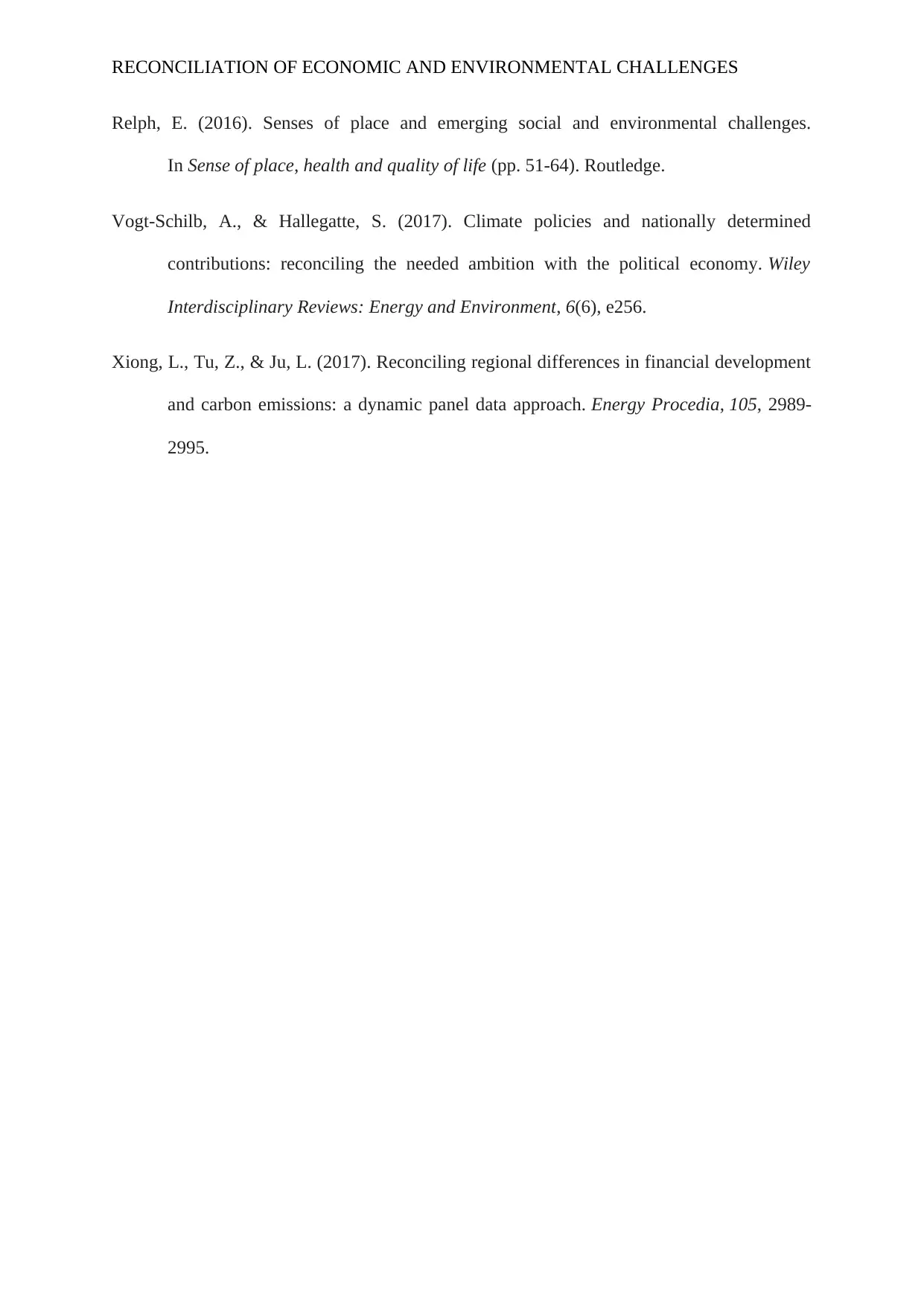
RECONCILIATION OF ECONOMIC AND ENVIRONMENTAL CHALLENGES
Relph, E. (2016). Senses of place and emerging social and environmental challenges.
In Sense of place, health and quality of life (pp. 51-64). Routledge.
Vogt‐Schilb, A., & Hallegatte, S. (2017). Climate policies and nationally determined
contributions: reconciling the needed ambition with the political economy. Wiley
Interdisciplinary Reviews: Energy and Environment, 6(6), e256.
Xiong, L., Tu, Z., & Ju, L. (2017). Reconciling regional differences in financial development
and carbon emissions: a dynamic panel data approach. Energy Procedia, 105, 2989-
2995.
Relph, E. (2016). Senses of place and emerging social and environmental challenges.
In Sense of place, health and quality of life (pp. 51-64). Routledge.
Vogt‐Schilb, A., & Hallegatte, S. (2017). Climate policies and nationally determined
contributions: reconciling the needed ambition with the political economy. Wiley
Interdisciplinary Reviews: Energy and Environment, 6(6), e256.
Xiong, L., Tu, Z., & Ju, L. (2017). Reconciling regional differences in financial development
and carbon emissions: a dynamic panel data approach. Energy Procedia, 105, 2989-
2995.
1 out of 8
Related Documents
Your All-in-One AI-Powered Toolkit for Academic Success.
+13062052269
info@desklib.com
Available 24*7 on WhatsApp / Email
![[object Object]](/_next/static/media/star-bottom.7253800d.svg)
Unlock your academic potential
Copyright © 2020–2025 A2Z Services. All Rights Reserved. Developed and managed by ZUCOL.



